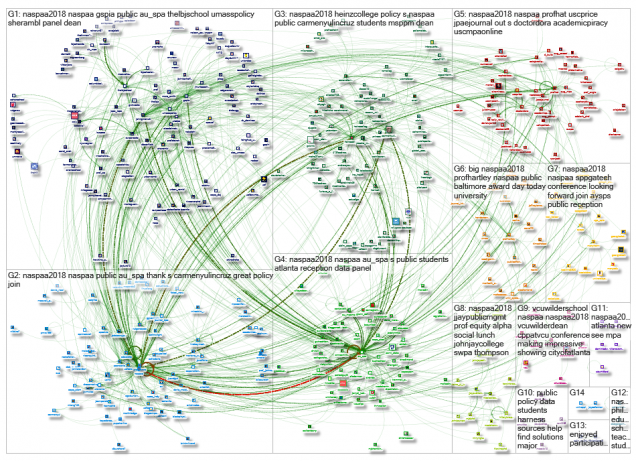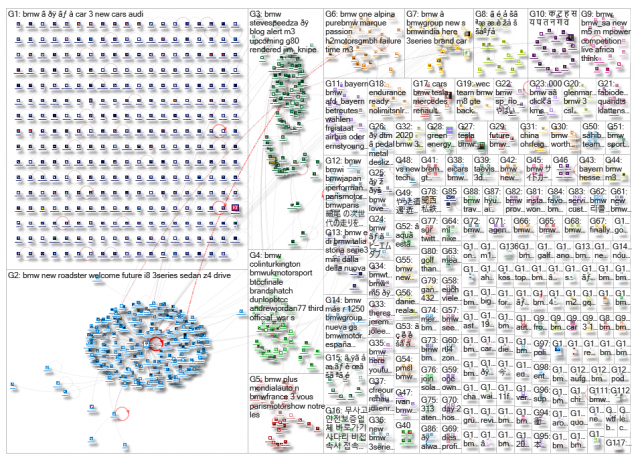Smith, Rainie, Shneiderman, and Himelboim have summarized six types of Twitter topic networks. With these ways of mapping networks, researchers can make a better understanding of the variety of ways individuals form groups and organize online (Himelboim et al, 2014). Notably, researchers can discuss the key people, groups, and topics. When mapping Twitter topic networks, we can see how individuals, which means users rather than media practitioner, shape network types.
Before exploring the relationship between users and network types, types of Twitter topic networks need to be clarified. In this essay, I will take two of these types as the examples, Tight Crowd network and Brand Clusters network.
NASPAA2018
The #NASPAA2018 hashtag, used in connection with Network of Schools of Public Policy, Affairs, and Administration Annual Conference, is an example of a Tight Crowd social media network. The #NASPAA2018 social media network dataset is available from https://nodexlgraphgallery.org/Pages/Graph.aspx?graphID=171274.
Network of Schools of Public Policy, Affairs, and Administration Annual Conference is held to chart the future of public service education and discuss how have NASPAA accreditation standards held up over the past decade. People like researchers, scholars, and educators tweet with the #NASPAA2018 hashtag to participate in the discussion and form a Tight Crowd network community map few isolates and a few small groups with significant interconnections.
The graph represents a network of 403 Twitter users whose recent tweets contained “#NASPAA2018”, or who were replied to or mentioned in those tweets, taken from a data set limited to a maximum of 18,000 tweets. The network was obtained from Twitter on Saturday, 13 October 2018 at 16:14 UTC.
Tight Crowd network community map illustrates high levels of internal connection (Himelboim et al, 2014). That means everyone who participates in this network has multiple connections. They communicate with each other, and few or no will be isolated. This type is always suitable for conferences, professional topics, hobby groups. As we can see from the graph below, people in the #NASPAA2018 social media network have connections with each other. We examined 403 Twitter users and found out they use this hashtag to express their thoughts of public service education. There is an edge for each “replies-to” relationship in a tweet, an edge for each “mentions” relationship in a tweet, and a self-loop edge for each tweet that is not a “replies-to” or “mentions”.

BMW
The #BMW hashtag yields an excellent example of a Brand Clusters network conversation: https://nodexlgraphgallery.org/Pages/Graph.aspx?graphID=171350.
All globally recognized firms have a distinctive structure of connection and conversation among the people who mention them (Himelboim et al, 2014). In this network map, people have no connections with each other at all. They do tweet about the same subject, but they do not make communications with other participants. BMW, an international car brand, has no exception in this network.
The graph represents a network of 1,330 Twitter users whose tweets in the requested range contained “#BMW”, or who were replied to or mentioned in those tweets. The network was obtained from the NodeXL Graph Server on Sunday, 14 October 2018 at 10:44 UTC.
As we can see from the graph, users tweet with the hashtag #BMW to express their thoughts of this brand and its products. While the interaction between participants is limited., users have little overlap concerning the content. Few URLs overlap across groups. There is an edge for each “replies-to” relationship in a tweet, an edge for each “mentions” relationship in a tweet, and a self-loop edge for each tweet that is not a “replies-to” or “mentions”.

Synthesis
As we can see from these Twitter topic networks, users become the determinant. All these structures of networks are determined by the structures of users. Take #NASPAA2018 hashtag which is a Tight Crowd network as an example; users create the content of this hashtag. Due to this topic, users will discuss with each other and form a Tight Crowd network. Definitely, users become the creators and determinant of the type of network.
This change is resulted from that users become the creators of the content. For traditional media, users are just receivers and can do nothing with the types of media. But for Twitter, the content can be created by any user which means the democratization of media participation. A significant impact of this democratization is that it enables a new breed of media creators to step onto the cultural stage (Rainie and Wellman, 2012). In this way, the content of the network will change according to to the users. As the creations of users change, the content and the type of network will change.
In a word, once users become creators, the content of the network will change. Therefore, the type of network will vary too.
Reference
Lee Rainie and Barry Wellman. (2012). Networked: The New Social Operating System. The MIT Press.
Marc A. Smith, Lee Rainie, Ben Shneiderman, and Ita Himelboim. (2014). Mapping Twitter Topic Networks: From Polarized Crowds to Community Clusters. Pew Research Center.
NodeXL Graph Gallery: http://nodexlgraphgallery.org
The archive of shared NodeXL network data sets and visualizations.